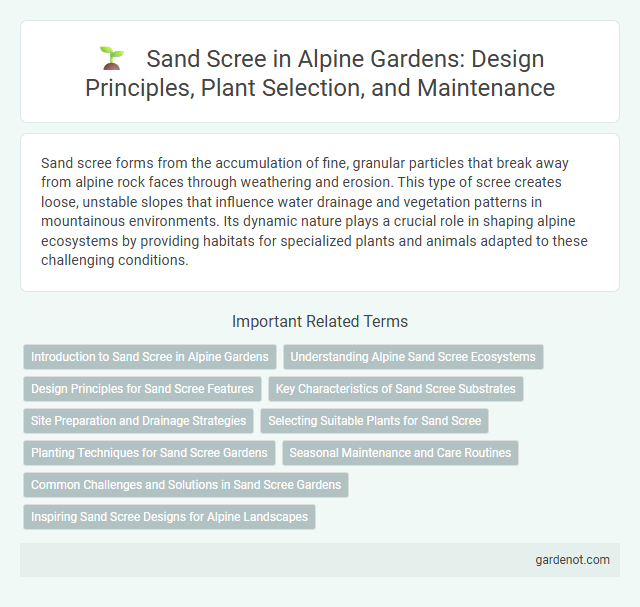Sand scree forms from the accumulation of fine, granular particles that break away from alpine rock faces through weathering and erosion. This type of scree creates loose, unstable slopes that influence water drainage and vegetation patterns in mountainous environments. Its dynamic nature plays a crucial role in shaping alpine ecosystems by providing habitats for specialized plants and animals adapted to these challenging conditions.
Introduction to Sand Scree in Alpine Gardens
Sand scree in alpine gardens consists of loosely packed, fine-grained sandy particles forming unstable slopes ideal for moisture drainage and root aeration. This substrate supports specialized alpine plants adapted to nutrient-poor, well-drained conditions, enhancing biodiversity and erosion control. Incorporating sand scree zones replicates natural mountain habitats, promoting healthy growth and resilience in alpine garden ecosystems.
Understanding Alpine Sand Scree Ecosystems
Alpine sand scree ecosystems consist of loose, coarse sand particles that create a dynamic habitat for specialized flora and fauna adapted to unstable substrate conditions. These environments support pioneer plant species with deep root systems, such as alpine sedges and cushion plants, which stabilize the scree and promote soil formation. The unique microclimate and drainage patterns within sand scree influence nutrient cycling and biodiversity, making these zones critical for alpine ecological balance.
Design Principles for Sand Scree Features
Sand scree features in alpine environments rely on design principles emphasizing stability and drainage to prevent erosion. Utilizing coarse, angular sand particles enhances interlocking, promoting structural integrity and reducing sediment displacement. Incorporating layered gradients with varying particle sizes improves water filtration and mimics natural alpine scree formations, optimizing habitat suitability for specialized flora and fauna.
Key Characteristics of Sand Scree Substrates
Sand scree substrates are characterized by loose, coarse-grained sand particles that provide high permeability and low water retention, creating well-drained but nutrient-poor conditions. Their unstable, shifting texture supports specialized alpine vegetation adapted to physical disturbance and rapid drainage. Thermal regulation in sand scree is notable, with rapid temperature fluctuations influencing microhabitat biodiversity and soil microbial activity.
Site Preparation and Drainage Strategies
Effective site preparation for sand scree involves stabilizing loose sandy substrates through graded contouring and minimal soil disturbance to reduce erosion. Drainage strategies prioritize installing permeable layers and French drains to facilitate rapid water runoff, preventing waterlogging and promoting slope stability. Incorporating native vegetation with deep root systems further enhances soil cohesion and natural water absorption capacity.
Selecting Suitable Plants for Sand Scree
Selecting suitable plants for sand scree requires choosing species with deep root systems and drought tolerance to stabilize loose, sandy substrates. Native grasses such as Festuca ovina and cushion plants like Silene acaulis effectively anchor sand scree while conserving moisture. Succulents like Sempervivum and certain alpine sedums enhance erosion control by thriving in nutrient-poor, well-drained sandy environments.
Planting Techniques for Sand Scree Gardens
Sand scree gardens require precise planting techniques that accommodate loose, well-drained substrates characterized by coarse, sandy particles. Selecting drought-tolerant and deep-rooted alpine species helps stabilize the sediment while preventing erosion and promoting natural water filtration. Incorporating layering methods, such as embedding plants in pockets or terraces, enhances root anchorage and maximizes nutrient access in nutrient-poor conditions.
Seasonal Maintenance and Care Routines
Sand scree in alpine environments requires seasonal maintenance to prevent erosion and ensure stability during freeze-thaw cycles. Regular inspection after winter snowmelt helps identify sediment displacement or vegetation loss, prompting timely regrading and reseeding with native alpine plants. Implementing erosion control measures, such as installing check dams or geotextiles, enhances long-term preservation of sand scree slopes.
Common Challenges and Solutions in Sand Scree Gardens
Sand scree gardens often face challenges such as poor nutrient retention, erosion risks, and water drainage issues due to the loose, granular nature of sand. Solutions include incorporating organic matter to improve soil fertility, using erosion control mats or barriers to stabilize slopes, and installing efficient drip irrigation systems to maintain optimal moisture levels. Selecting drought-tolerant plants adapted to sandy, well-drained environments enhances garden resilience and long-term success.
Inspiring Sand Scree Designs for Alpine Landscapes
Sand scree formations in alpine landscapes create dynamic, textured surfaces that enhance natural erosion patterns and support unique microhabitats. Innovative design approaches incorporate the fine granularity and shifting properties of sand scree to stabilize slopes while promoting biodiversity. These inspiring sand scree designs balance aesthetic appeal with ecological function, making them ideal for sustainable alpine environment management.
Sand scree Infographic

 gardenot.com
gardenot.com